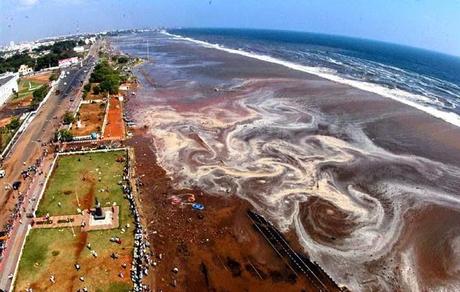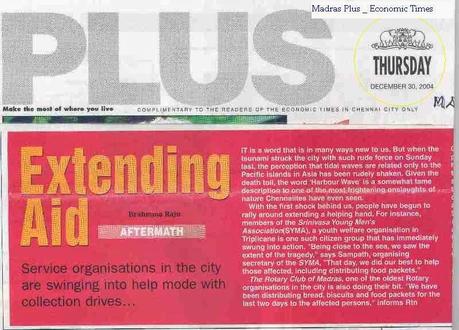The word is now a commoner …. Around 15 years ago – not many country knew its pronunciation nor its meaning … all that changed on that Black Sunday !! – perhaps it occurred earlier but known by that name – perhaps a similar thing only undid Dhanushkodi – and earlier in 1930s …. It is ‘tsunami’ (from Japanese – a harbor wave) - a series of water waves caused by the displacement of a large volume of a body of water, generally an ocean or a large lake. Earthquakes, volcanic eruptions and other underwater explosions (including detonations of underwater nuclear devices), landslides, glacier calvings, meteorite impacts and other disturbances above or below water all have the potential to generate a tsunami. Tsunami waves do not resemble normal sea waves, because their wavelength is far longer.
 temblor effect - Marina - Express photo
temblor effect - Marina - Express photo
Wave heights of tens of metres can be generated by large events. Although the impact of tsunamis is limited to coastal areas, their destructive power can be enormous and they can affect entire ocean basins; the 2004 Indian Ocean tsunami was among the deadliest natural disasters in human history with at least 290,000 people killed or missing in 14 countries bordering the Indian Ocean.
The 2004 Indian Ocean earthquake was an undersea megathrust earthquake that occurred at 00:58:53 UTC on Sunday, 26 December 2004, with an epicentre off the west coast of Sumatra, Indonesia. The quake itself is known by the scientific community as the Sumatra–Andaman earthquake. The resulting tsunami was given various names, including the 2004 Indian Ocean tsunami, South Asian tsunami, Indonesian tsunami, the Christmas tsunami and the Boxing Day tsunami. The earthquake was caused when the Indian Plate was subducted by the Burma Plate and triggered a series of devastating tsunamis along the coasts of most landmasses bordering the Indian Ocean, killing over 230,000 people in fourteen countries, and inundating coastal communities with waves up to 30 meters (100 ft) high. It was one of the deadliest natural disasters in recorded history. Indonesia was the hardest-hit country, followed by Sri Lanka, India, and Thailand.
Sunday morning usually begins lazily with levity. The residents of Chennai were woken up to a rude shock. It was literally earth shattering. Many did not really know. Some thought it was their own indisposition. At morning 6.28 am on 26th Dec 2004, Chennai was hit by tremors. The tremor had its epicenter 257 km south east of Banda Aceh, Indonesia and measured 8.9 on the Richter scale making it the most powerful earthquake in the World in the last 40 years. The epicenter was actually 2028 km south east of Chennai; the worst was to follow. The residents who assembled out of their homes, talked to each other and after a while everything was back to normal or so it appeared.
Srinivas Youngmens Association [SYMA] wedded to social service, had organized collection of used clothes for Rajasthan cloth bank and its volunteers - we were out in the streets campaigning. We had a rickshaw fitted with mike – blurring out recorded message and live appeal requesting local people to contribute Around 8.45 am, when were camping around Vasudevapuram, off Dr Besant Road, there was commotion that sea water had entered inside. Out of sheer eagerness, we also rushed towards Vivekananda beach. The sight was incredible. What had happened in Marina? – we saw people running with fear – some were carrying TV, utensils and whatever they could – some were simply running with children on their head and shoulders…. Clearly fear had gripped the inmates of Ayodhya Nagar and other slums living in the vicinity of the beach.
One could see sheets of water on the Beach road – nearer Besant statue and Vivekanandar illam … remember Chennai shore has little elevation – the sands of Marina extend almost around 1 to 1.5 kilometers from sea to the road – then there is inner road made of thar – there is elevation again, as one reaches Kamarajar Salai aka Beach road – and it is this beach road where sea water was running !
It was a Sunday, the day after Christmas. Holiday-makers, picnicers, children, morning walkers, vendors, fisherfolk - , they were all there on the golden sands of the Marina Beach. The 3 km-long beach which is the longest in Asia and has the memorials of two former CM.s of TN, and various other structures, could accommodate all of them and more. Scores of boys had taken positions on their regular playing ground for a game of cricket. There were tourists on the shore, to feel the tickle of water and sand under their feet. Fishermen, who had returned at daybreak after a night at sea, were mending their nets. Fish vendors were building for the catch that had been sorted out. It was like any other Sunday on the Marina. Out of the calm blue sea, tiny waves inched towards the shores. Then, unbelievably, they rose in unison to form a giant wall of water, only to come crashing down on all those who thought the Marina was their home ground. In its furious fall, the water swept across the expanse of the beach and its walkways, and even crossed the Kamarajar Salai to enter buildings on the other side. The sea went back after making one more trip, at 10 a.m. but after swallowing people and dragging much of the beach sands back.
The gravity of the situation was not understood by the curious onlookers – in decades, we have never seen sea rushing so long – later pictures were to reveal how a car stationed near labor statue was violently cradled …… but as we waded in knee deep water – we were to hear some sad stories – a man was frantically searching for his son who was playing cricket …. then a group of people from nearby slums were anxiously carrying a woman who was not breathing – there were stories of dozen people drowned or seen unconscious – everyone was trying to do something – but mostly directionless, no clue of what had struck and not knowing what to do !!! – a group of us tried regulating the traffic.
Once back at home around 10.30 am – there was news of a tidal wave arising out of earthquake having struck in many coastal areas – there was so many footage showing vehicles and bigger objects being taken into the sea by the rough waves retreating. At noon, all that remained of the Marina was knee-deep cesspools. Catamarans, fibreglass boats with outboard motors, cracked country boats, pushcarts and motorbikes, lay mangled. Cars parked on the service lane of the beach were lifted by the surging waters and thrown around; one car lay perched on a stone bench on what were once lawns.
Having not experienced such a thing, the reaction of the city was curious. They were descending in thousands towards the beach just to see what was happening. There was a surge of crowd at the waterways - the Adyar river and the Cooum which winds through the city. The rivers were flowing backwards. That was the first sign of the tsunami people living some distance from the beach noticed. The monster waves triggered by seismic activity introduced a new phenomenon, hitherto unknown to this part of the world. These tidal waves are called tsunami, a Japanese word meaning harbor waves. The Poseidon in all its fury lasted only a few minutes but the aftermath was ghastly. Tsunami reportedly had hit India earlier in 1941 and before that in 1881 in Andaman and Nicobar Islands, The sea water upsurge was reportedly recorded more times on the same day, but fortunately no fresh damage.
The city which realized the fury only much later, and after repeated TV footages and many news bulletins started reacting. We at SYMA after the intial shock came to grips and around noon started collecting rice, foodgrains and vegetables. We used the same vehicle that we had put up for collection of clothes. We went around first the mada veethis of Thiruvallikkeni and then extended our trip into smaller bylanes too. First we bought few kgs of vegetables as the market was closing down – it was mostly brinjals and pumpkins. The kindhearted authorities of SHG Terapanth Bhavan permitted usage of the choultry and cooking started. Scores of volunteers assisted them, cutting vegetables, and in other possible manner. A team of cooks (professionals and otherwise headed by Durai, a master cook) started the work….. initially, some hot water was boiled and in that tamarind was mixed – the available vegetables were put in them – an immediate attempt to make some sambar rice.
Triplicanites spontaneously came out in larger numbers providing succour. Lot of friendly associations like Seva Bharathi, Vivekananda Kendra, Sastha Samajam from Ambattur chipped in and together we were able to provide food for 15,000 and more. The Ambattur Sastha Samaj had arranged for an Iyyappa Pooja – send of their people in pilgrimmage to Sabarimala and distribution of food on that occasion. They diverted the food that they were making. Our volunteers with so many others went to the affected areas and distributed food and water. The kitchen was busy late in the night also. I alongwith truck load of hot food reached out the banks of Coovum alongside Chintadripet – nearer Chitra theater – there were (in those days) many slums – when the sea water flowed inwards – it carried heavy slush, entered their homes – hundreds were on the streets – awaiting eagerly for food – we had lorry load of cooked rice dish and the same was distributed.
Meantime, the Govt. authorities were doing great job. They had placed hundreds of people who had moved out from areas close to the sea and made arrangements for them at various Corporation school. Chennai Corporation – the Zonal Office at Triplicane had wartime planning. Mr AC Soundaiah heading the Zone was an expert planner – he knew where people had been placed and what exactly was the immediate need. We coordinated with Corporation authorities and were fully assisted by the Inspector of Police of D3 PS- Mr. M.Chandrasekaran – the Govt machinery was in full swing, doing a great job. It was late in the night that the volunteers started feeling tired and thought of heading back to home.
Triplicane and most of other areas by then had developed mortal fear – many left the coastal zone to stay with their relatives. As you would have read by now – we were all talking about what happened in Marina and its vicinity – though much was shown in TV, the reality that Tsunami had wrecked havoc in coastal Tamilnadu was relatively not understood. In fact, Chennai was least affected when compared to Cuddalore and Nagapattinam and globally to Sri Lanka and Indonesia.
Next morning, when more was needed Sri Parthasarathy Swami Koil Devasthanam provided cooked food in large quantity. We lodged the provisions and other items collected by us with the Corporation Relief Centre at Chintadripet. We still had the burning urge to do something more, had rounds of discussions on possible ways in partaking in the relief operations.
That was unfolding of events on day 1 – on Sunday, 26th Dec 2004 – more was to follow.
With regards – S. Sampathkumar.

The unfortunate event on Black Sunday claimed lives of many … SYMA was at the forefront; alongside many other Organisations and individuals did relief work at Chennai, later at Cuddalore, Nagapattinam and Poompuhar. This is depiction of our reaction on day 1 … as detailed in SYMA Bliss Jan 2005 issue – now posted on web here.

